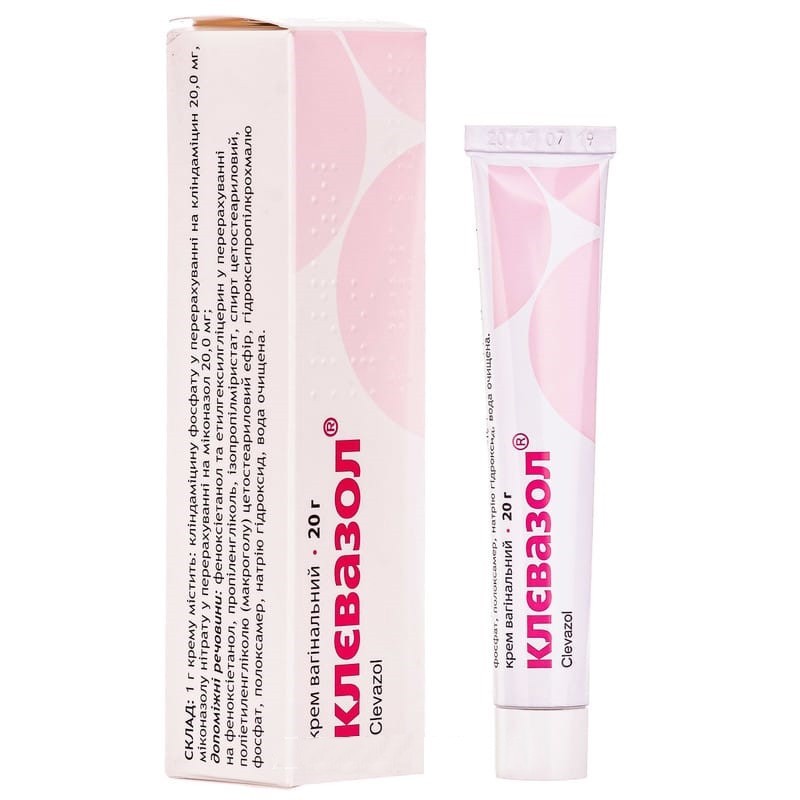Clevazol® [Clindamycin, Miconazole]
 Secure and encrypted payment processing
Secure and encrypted payment processing We ship to over 40 countries including the USA, UK, Europe, Australia and Japan
We ship to over 40 countries including the USA, UK, Europe, Australia and Japan Guaranteed refund or reship if you haven't received your order
Guaranteed refund or reship if you haven't received your order
Pharmacological properties
clindamycin phosphate is an ester of clindamycin or 7- (s) -chlorolinecomycin, a semi-synthetic antibiotic. this antibiotic binds predominantly to the 50s ribosomal subunit and affects the protein chain initiation process. although clindamycin phosphate is inactive in vitro, in vivo it rapidly undergoes hydrolysis to form clindamycin, which is characterized by antibacterial activity.
In vitro clindamycin is active against microorganisms that cause bacterial vaginosis, including Gardnerella vaginalis, Mobiluncus mulieris, Mobiluncus curtisii, Mycoplasma hominis and anaerobes (species Peptostreptococcus and Bacteroides).
Miconazole nitrate is a local antifungal and antibacterial drug with a wide spectrum of action of the imidazole group. Miconazole inhibits ergosterol biosynthesis and changes the lipid composition of the membrane, causing the death of the fungal cell. It has a fungicidal effect on dermatophytes (Trichophyton rubrum, Trichophyton mentagrophytes, Epidermophyton floccosum, Microsporum canis), yeast and yeast-like fungi (Candida albicans, Candida glabrata and other Candida species, Malusperium fungi (Malasse Penza) ) Miconazole nitrate has an antibacterial effect, more pronounced against gram-positive bacteria.
Pharmacokinetics After intravaginal administration, once a day, 100 mg of clindamycin phosphate in a concentration equivalent to 20 mg of clindamycin in 1 g of cream, Cmax in plasma, clindamycin reaches an average of 20 ng / ml (range - 3–93 ng / ml). About 3% (0.1–7.0%) of the administered dose is absorbed systemically.
According to other studies of systemic absorption of clindamycin (based on AUC) when administered intravaginally to healthy volunteer patients, 1 suppository with clindamycin phosphate 1 time per day compared with a similar dose of clindamycin in the form of a vaginal cream, systemic absorption with cream was approximately 7 times lower than after administration of suppository: average values for vaginal cream AUC and Cmax amounted to 0.4 μg • h / ml (ranging from 0.13 to 1.16 μg • h / ml) and 0.02 μg / ml (ranging from 0.01 to 0.07 μg / ml), respectively.
After the introduction of 100 mg of clindamycin phosphate (20 mg / g) into the vagina, the amount of clindamycin that is absorbed is 4%. With intravaginal administration of miconazole, nitrate is absorbed in a small amount (approximately 1.4% of the dose). Miconazole nitrate is not detected in plasma with intravaginal administration. Miconazole is excreted in the urine in the form of metabolites.
Indications
Mixed (bacterial and fungal) vulvovaginal infections, secondary and superinfection caused by bacteria and fungi sensitive to the drug.
Application
The recommended dose is 1 full applicator (5 g of cream, corresponding to 100 mg of miconazole nitrate and 100 mg of clindamycin). the cream is administered intravaginally, mainly before bedtime for 7 consecutive days.
Instructions for use of the applicator:
1. Remove the bush from the tube with cream and screw the plastic applicator onto the tube. Squeeze the cream into the applicator until it is completely filled. Disconnect the applicator and close the tube with a bush.
2. Lying on your back, carefully insert the applicator as deep as possible into the vagina.
3. Slowly pressing the piston, squeeze the cream from the applicator.
4. Remove the empty applicator from the vagina and discard it.
Contraindications
Hypersensitivity to clindamycin phosphate or lincomycin, miconazole nitrate and to any component of the drug.
The drug is contraindicated in patients with regional enteritis, ulcerative colitis and in patients with a history of colitis associated with the use of antibiotics.
Side effects
From the immune system: hypersensitivity, allergic reactions, including urticaria, anaphylactoid reactions.
General disorders of the body as a whole: generalized pain, fever.
At the injection site: burning, itching, pain at the injection site, localized edema (vaginitis).
From the reproductive system and mammary glands: vulvovaginal irritation, menstrual irregularities, uterine bleeding, vaginal discharge, endometriosis, pelvic pain.
From the gastrointestinal tract: localized pain in the lower abdomen, spasmodic abdominal pain, generalized abdominal pain, bad breath, heartburn, bloating, diarrhea, nausea, vomiting, flatulence, dyspepsia, constipation.
On the part of the skin and subcutaneous tissues: erythema, rash, itching (not at the injection site), maculopapular rash.
From the kidneys and urinary system: dysuria, urinary tract infections, glucosuria, proteinuria.
From the musculoskeletal system and connective tissue: back pain.
Infections and infestations: vaginal infections, bacterial infections.
From the nervous system: dizziness, headache, dysgeusia.
Clevazole cream for intravaginal use has a slight absorption, so the likelihood of systemic reactions is extremely low.
With the systemic use of one of the components of the drug clindamycin, the following adverse reactions are described.
From the endocrine system: hyperthyroidism.
From the respiratory system: nosebleeds, upper respiratory tract infections.
On the part of the blood and lymphatic system: temporary neutropenia (leukopenia), agranulocytosis, thrombocytopenia.
From the skin and subcutaneous tissues: erythema multiforme, similar to Stevens-Johnson syndrome, toxic epidermal necrolysis.
From the hepatobiliary system: jaundice.
From the side of the organ of hearing and balance: vertigo.
Pregnancy, postpartum and perinatal conditions: pathological birth.
Laboratory results: microbiological test is not normal.
special instructions
Before starting the use of the drug, it may be necessary to conduct a laboratory analysis for the presence of other pathogens of infections, including trichomonas vaginalis, chlamydia trachomatis and gonococci.
During or after the use of antimicrobial agents, symptoms may occur indicating pseudomembranous colitis. Cases of pseudomembranous colitis have been reported with almost all antibacterial agents, and severity can range from mild to life-threatening. Therefore, it is necessary to consider this possibility in patients who have developed diarrhea after using antibacterial agents. After discontinuation of the drug, the severity of symptoms of mild disorder may decrease.
In case of pseudomembranous diarrhea, the drug should be discontinued. Appropriate antibacterial treatment should be prescribed. Drugs that inhibit peristalsis are contraindicated in this case.
It is recommended to prescribe the drug with caution to patients with inflammatory bowel disease, in particular Crohns disease.
It is not recommended to use the drug Clevazole simultaneously with other products intended for intravaginal administration (such as tampons, douching products).
Avoid contact with the eyes and mouth.
During treatment, douching, the use of tampons, and soap with acidic pH, which can reduce the effectiveness of the drug, are not recommended. Patients should be warned that during treatment it is necessary to refrain from sexual intercourse.
The cream contains ingredients that can damage latex or rubber products, such as condoms or vaginal contraceptives. Therefore, these products should not be used while taking the drug.
It is not recommended to use such drugs within 72 hours after treatment, since their contraceptive effectiveness and protective properties against sexually transmitted diseases can be reduced.
If there is severe irritation of the vaginal mucosa or if you feel acute pain, the patient should immediately consult a doctor.
Propylene glycol can cause skin irritation.
Cetostearyl alcohol can cause local skin reactions (e.g. contact dermatitis).
With the development of an allergic reaction, it is necessary to stop taking the drug.
Violation of the method of use of the drug can lead to the resistance of microorganisms and their increased growth.
Use during pregnancy and lactation. Clevazole cream for intravaginal administration is contraindicated during the first trimester of pregnancy.
There are no well-controlled studies on the use of the drug in pregnant women.
It is not known whether miconazole and clindamycin passes into breast milk after applying Clevazole vaginal cream. However, the presence of clindamycin in breast milk has been reported following oral or parenteral administration. Nevertheless, the ratio of benefit and risk should be carefully evaluated, prescribing Clevazole cream intravaginally during lactation.
With intravaginal use of Clevazole cream in preclinical studies, no teratogenic and embryotoxic effects were detected.
According to clinical studies, the use of one of the components of the drug - clindamycin phosphate - in the form of a vaginal cream in women during the second trimester of pregnancy led to an increase in the incidence of congenital anomalies.
According to the FDA, miconazole nitrate belongs to category C in terms of teratogenicity potential. The absence of its embryotoxic, fetotoxic, teratogenic effects with intravenous use in animals in preclinical studies has been proved.
Along with this, clinical studies on the use of miconazole in pregnancy are absent.
Considering the data of preclinical studies of the drug Clevazole cream and the data of clinical studies of the components of the drug, Clevazole cream can be used during the II and III trimesters of pregnancy under the supervision of a doctor in cases where, according to the doctor, the potential benefits of the treatment outweigh the potential risk to the fetus.
Children. Safety and efficacy of the drug in children have not been established. There is no experience with the use of the drug in children.
The ability to influence the reaction rate when driving vehicles and working with other mechanisms. No data available.
Interactions
There is cross-resistance between clindamycin and lincomycin. in vitro antagonism between clindamycin and erythromycin has been demonstrated.
Caution should be exercised with the simultaneous use of clindamycin and drugs that block neuromuscular conduction, due to the possibility of strengthening and prolonging myoplegia.
The interaction of miconazole with isoforms of CYP 2C9 and CYP 3A4 of the cytochrome P450 system was noted. Miconazole potentiates the action of oral anticoagulants (eg warfarin) and other drugs that undergo biotransformation with CYP 2C9 enzymes (eg oral hypoglycemic drugs and phenytoin) and CYP 3A4 (for example, HMG-CoA reductase inhibitors - simvastatin, lovastidiatin, calvastidine; ) Therefore, miconazole therapy must be carried out under the supervision of a physician. With simultaneous use with anticoagulants, it is necessary to monitor the prothrombin index.
In the treatment with the drug, other vaginal drugs should not be used.
The use of the drug Clevazole reduces the reliability of mechanical contraception (latex agents: condoms, vaginal diaphragms).
Overdose
When administered intravaginally, the drug cannot be absorbed in quantities sufficient to cause systemic side effects. with random ingestion, effects may occur that are comparable to those with therapeutic concentrations of clindamycin in case of systemic use, that is, the drug can be absorbed in quantities sufficient to cause systemic effects. in case of an overdose, general symptomatic and supportive measures should be taken if necessary.
Storage conditions
At a temperature not exceeding 25 ° C. do not freeze.

